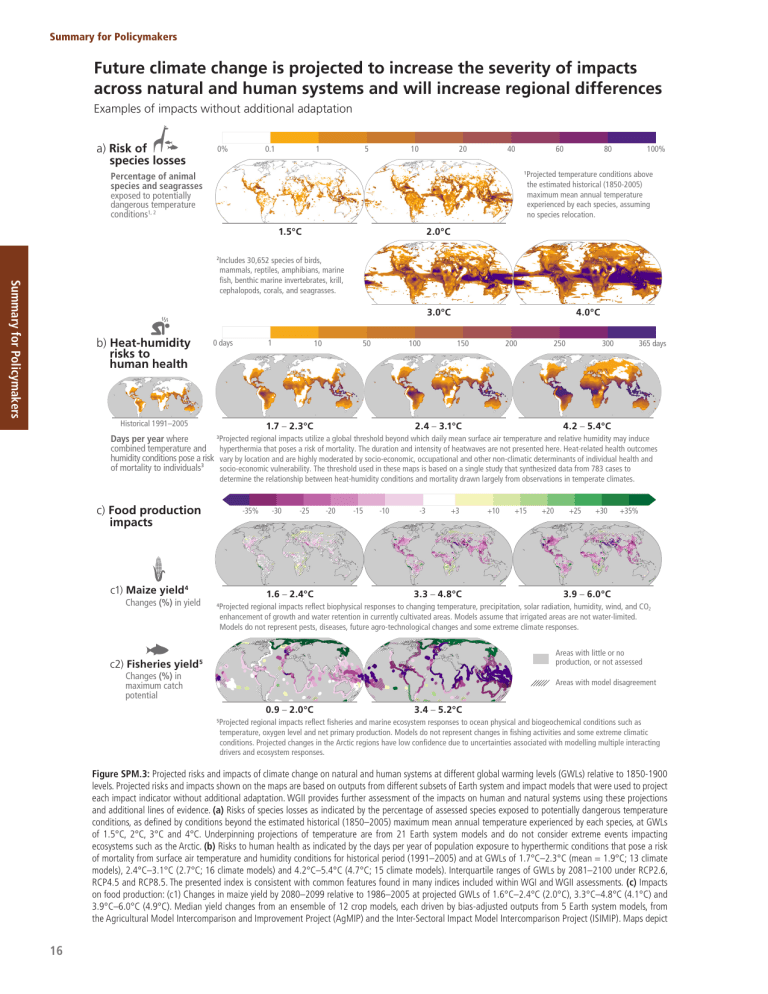
Summary for Policymakers Future climate change is projected to increase the severity of impacts across natural and human systems and will increase regional differences Examples of impacts without additional adaptation a) Risk of species losses 0% 0.1 1 5 10 20 40 60 1 Percentage of animal species and seagrasses exposed to potentially dangerous temperature conditions1, 2 Projected temperature conditions above the estimated historical (1850-2005) maximum mean annual temperature experienced by each species, assuming no species relocation. Summary for Policymakers Includes 30,652 species of birds, mammals, reptiles, amphibians, marine fish, benthic marine invertebrates, krill, cephalopods, corals, and seagrasses. 3.0°C b) Heat-humidity risks to human health 100% 2.0°C 1.5°C 2 80 0 days 1 10 50 100 4.0°C 150 200 250 300 365 days Historical 1991–2005 1.7 – 2.3°C 2.4 – 3.1°C 4.2 – 5.4°C 3 Projected regional impacts utilize a global threshold beyond which daily mean surface air temperature and relative humidity may induce Days per year where combined temperature and hyperthermia that poses a risk of mortality. The duration and intensity of heatwaves are not presented here. Heat-related health outcomes humidity conditions pose a risk vary by location and are highly moderated by socio-economic, occupational and other non-climatic determinants of individual health and of mortality to individuals3 socio-economic vulnerability. The threshold used in these maps is based on a single study that synthesized data from 783 cases to determine the relationship between heat-humidity conditions and mortality drawn largely from observations in temperate climates. c) Food production impacts -35% c1) Maize yield4 Changes (%) in yield -30 -25 1.6 – 2.4°C 4 -20 -15 -10 -3 +3 3.3 – 4.8°C +10 +15 +20 +25 +30 +35% 3.9 – 6.0°C Projected regional impacts reflect biophysical responses to changing temperature, precipitation, solar radiation, humidity, wind, and CO2 enhancement of growth and water retention in currently cultivated areas. Models assume that irrigated areas are not water-limited. Models do not represent pests, diseases, future agro-technological changes and some extreme climate responses. Areas with little or no production, or not assessed c2) Fisheries yield5 Changes (%) in maximum catch potential Areas with model disagreement 0.9 – 2.0°C 3.4 – 5.2°C Projected regional impacts reflect fisheries and marine ecosystem responses to ocean physical and biogeochemical conditions such as temperature, oxygen level and net primary production. Models do not represent changes in fishing activities and some extreme climatic conditions. Projected changes in the Arctic regions have low confidence due to uncertainties associated with modelling multiple interacting drivers and ecosystem responses. 5 Figure SPM.3: Projected risks and impacts of climate change on natural and human systems at different global warming levels (GWLs) relative to 1850-1900 levels. Projected risks and impacts shown on the maps are based on outputs from different subsets of Earth system and impact models that were used to project each impact indicator without additional adaptation. WGII provides further assessment of the impacts on human and natural systems using these projections and additional lines of evidence. (a) Risks of species losses as indicated by the percentage of assessed species exposed to potentially dangerous temperature conditions, as defined by conditions beyond the estimated historical (1850–2005) maximum mean annual temperature experienced by each species, at GWLs of 1.5°C, 2°C, 3°C and 4°C. Underpinning projections of temperature are from 21 Earth system models and do not consider extreme events impacting ecosystems such as the Arctic. (b) Risks to human health as indicated by the days per year of population exposure to hyperthermic conditions that pose a risk of mortality from surface air temperature and humidity conditions for historical period (1991–2005) and at GWLs of 1.7°C–2.3°C (mean = 1.9°C; 13 climate models), 2.4°C–3.1°C (2.7°C; 16 climate models) and 4.2°C–5.4°C (4.7°C; 15 climate models). Interquartile ranges of GWLs by 2081–2100 under RCP2.6, RCP4.5 and RCP8.5. The presented index is consistent with common features found in many indices included within WGI and WGII assessments. (c) Impacts on food production: (c1) Changes in maize yield by 2080–2099 relative to 1986–2005 at projected GWLs of 1.6°C–2.4°C (2.0°C), 3.3°C–4.8°C (4.1°C) and 3.9°C–6.0°C (4.9°C). Median yield changes from an ensemble of 12 crop models, each driven by bias-adjusted outputs from 5 Earth system models, from the Agricultural Model Intercomparison and Improvement Project (AgMIP) and the Inter-Sectoral Impact Model Intercomparison Project (ISIMIP). Maps depict 16


